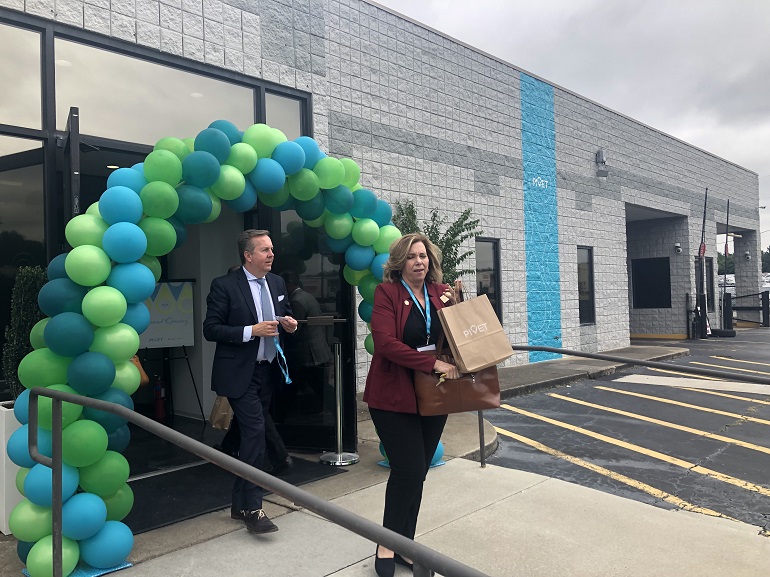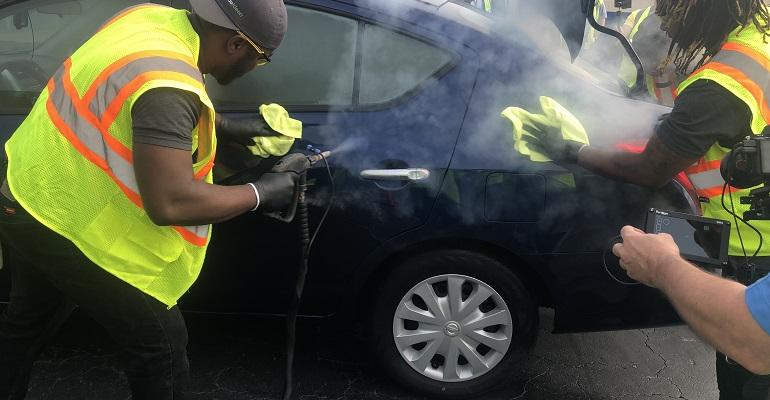ATLANTA – In a gritty section of this city’s south side sits a brick-block building. Despite its non-descript appearance, it’s a house of innovation for new-age transportation services.
The Cox Automotive Mobility Group’s recently opened Manheim Metro Atlanta Fleet Hub is billed as an industry-first mobility-fleet-services facility.
Cox executives foresee fleet services booming in coming years as more and more high-utilization vehicles hit the road. Cox wants in on that action.
The 35,000-sq.-ft. (3,251-sq. m) building is a place where Lyft and Uber drivers can get vehicles serviced while relaxing in their own lounge.
There is a state-of-the-art reconditioning center with high-tech equipment for servicing vehicles equipped with advanced driver-assist systems, including LIDAR, 3-D radar that uses windshield cameras.
It’s complicated componentry that needs to be maintained, calibrated and fixed properly. “You don’t want to be going 80 mph on the highway and have the LIDAR slightly off,” says Alex Taylor, president and CEO of Cox Enterprises.
Private-vehicle ownership isn’t expected to disappear. But the mobility-as-a-service trend foretells greater fleet ownership, especially when autonomous vehicles make the scene.
 “We believe more vehicles will be owned by fleets,” says Alex Fraser, who manages the service hub, once home of a Manheim auto auction. “We know 60% of routine maintenance goes undone (for privately owned vehicles). If you are a fleet owner, you need to do that maintenance.” (Guests at hub's grand opening, left)
“We believe more vehicles will be owned by fleets,” says Alex Fraser, who manages the service hub, once home of a Manheim auto auction. “We know 60% of routine maintenance goes undone (for privately owned vehicles). If you are a fleet owner, you need to do that maintenance.” (Guests at hub's grand opening, left)
Fleet operators of the future likely will include car dealers, he adds. “We know dealers will be in this business somehow, some way. So, we need to provide service to them.”
The facility maintains 50 Chevrolet Bolt battery-electric vehicles that Lyft drivers can rent through a joint program intended, in part, to better familiarize both drivers and riders with EVs.
“EVs will be the wave of the future for ride sharing,” Tim Echols, a Georgia Public Service Commissioner, predicts at the hub opening ceremonies.
His family ran a car auction at the place before selling it to Manheim. Echols sheepishly recalls working at the family business as a youth, and accidently backing an auction vehicle into another on his first day on the job.
The grand opening includes employees of RideKleen, another Cox company, demonstrating how they steam clean vehicles on the go using portable equipment carried on a light truck. RideKleen currently operates in 10 markets.
“Typically, it takes 40 gallons of water to clean a car,” says RideKleen CEO Pratik Patel. “We use one gallon, inside and out.”
Zipcar, a vehicle-sharing company, was RideKleen’s first customer, he says. “We can wash a car on the street, in a parking deck or at someone’s home. We’re doing fleets now, but we’re headed toward doing personal cars. We just released an app people can use to order a car wash.”
Of 17.2 million light vehicles sold in the U.S. last year, fleet units were up 4.3% while new-vehicle retail sales and leases fell 0.4% and 0.2%, respectively, according to Cox.
Of the movement towards more fleet-owned vehicles, Sandy Schwartz, CEO of Cox Automotive, says: “We can be part of the future.”
 At the hub opening, he speaks with a group of journalists. Here is an edited transcript of that Q&A.
At the hub opening, he speaks with a group of journalists. Here is an edited transcript of that Q&A.
Q: This former Manheim auction has been transformed into a mobility center. Do you see an opportunity to do something similar at other Manheim auction properties? (Sandy Schwartz, left)
Schwartz: Change is coming. We’re not going to get caught flat-footed. The purpose of this demonstration center is a) to hone our skills and b) to start understanding a lot of things.
There is so much more to learn. This will get us off the ground and push us to invest money and figure out the future.
There are other places where we will turn part of a Manheim auction into something like this. The reason we did this one is because it is five miles from the airport and five miles from downtown, in a part of town we think people need more access to vehicles.
Strategically, the geographical location has to match. We’re not going to limit ourselves just to the auctions.
Q: Are business decisions involving something like this new facility made from a gut feeling that something is going on and you want to be part of it? Or are you getting data that suggests that? Or is it a combination of the two?
Schwartz: It’s a couple of things. We invested $3 million in this, which is and isn’t a lot of money in the scheme of things. We’re just dipping our toe in the water.
We use data and look at everything. Sometimes, the more I look at it, the more confused I get.
There are some gut things we do. My executive team recently spent an entire day discussing digital automotive retailing. It means something different to everybody. We’re asking where we fit in this ecosystem.
The answer to your question is we are doing as much as we can with empirical data, but I have to tell you, some of this still is gut.
Q: Do you learn from mistakes or do you just learn not to make the same mistake again?
Schwartz: I hope we learn from them. But sometimes you scratch your head and say, “What was I thinking?” Some things just don’t work out as planned. Some mistakes are easier to learn from than others.
Q: What are the revenue prospects for a place like this?
Schwartz: Servicing fleets will be a big business. It will be different. We’ll have places like this, but much of it will be mobile, too. It’s going to be a big business, and we need to be in it.
That said, we’ll make money here, not just stopgap revenue. In the end, there will be a big payoff for people who are in this business, know it well and know how to do it.





